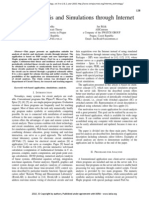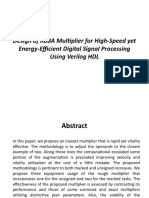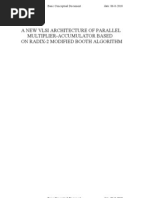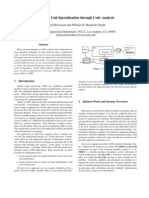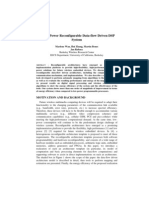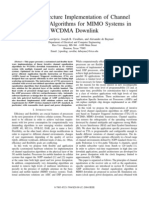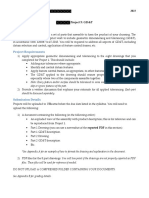A New VLSI Architecture of Parallel Multiplier-Accumulator Based On Radix-2 Modified Booth Algorithm
A New VLSI Architecture of Parallel Multiplier-Accumulator Based On Radix-2 Modified Booth Algorithm
Uploaded by
Nsrc Nano ScientifcCopyright:
Available Formats
A New VLSI Architecture of Parallel Multiplier-Accumulator Based On Radix-2 Modified Booth Algorithm
A New VLSI Architecture of Parallel Multiplier-Accumulator Based On Radix-2 Modified Booth Algorithm
Uploaded by
Nsrc Nano ScientifcOriginal Title
Copyright
Available Formats
Share this document
Did you find this document useful?
Is this content inappropriate?
Copyright:
Available Formats
A New VLSI Architecture of Parallel Multiplier-Accumulator Based On Radix-2 Modified Booth Algorithm
A New VLSI Architecture of Parallel Multiplier-Accumulator Based On Radix-2 Modified Booth Algorithm
Uploaded by
Nsrc Nano ScientifcCopyright:
Available Formats
A New VLSI Architecture of Parallel MultiplierAccumulator Based on Radix- Modified Booth Al!
orithm AIM The main aim of the project is to design A New VLSI Architecture of Parallel MultiplierAccumulator Based on Radix- Modified Booth Al!orithm. (ABSTRACT) In this paper, we proposed a new architecture of multiplier-andaccumulator (MAC) for high-speed arithmetic. By combining multiplication with accumulation and de ising a hybrid type of carry sa e adder (C!A), the performance was impro ed. !ince the accumulator that has the largest delay in MAC was merged into C!A, the o erall performance was ele ated. "he proposed C!A tree uses #$s-complement-based radi%-& modified Booth$s algorithm (MBA) and has the modified array for the sign e%tension in order to increase the bit density of the operands. "he C!A propagates the carries to the least significant bits of the partial products and generates the least significant bits in ad ance to decrease the number of the input bits of the final adder. Also, the proposed MAC accumulates the intermediate results in the type of sum and carry bits instead of the output of the final adder, which made it possible to optimi'e the pipeline scheme to impro e the performance. "he proposed architecture was synthesi'ed with &(), #*) and #+) m, and ,) nm standard CM-! library. Based on
..Malli/ar0una (1ro0ect manager) Mobile 2o3 "#$-% #&'&%'''. Branches) 12dera3ad 4
IS() #**$Na!pur
**% +,R-I.I,/ +(MPAN0
the theoretical and e%perimental estimation, we analy'ed the results such as the amount of hardware resources, delay, and pipelining scheme. 4e used !a/urai$s alpha power law for the delay modeling. "he proposed MAC showed the superior properties to the standard design in many ways and performance twice as much as the pre ious research in the similar cloc/ fre5uency. 4e e%pect that the proposed MAC can be adapted to arious fields re5uiring high performance such as the signal processing areas. Proposed Method: In this architecture a new architecture of multiplier-and-accumulator (MAC) for high-speed arithmetic is proposed. By combining multiplication with accumulation and de ising a hybrid type of carry sa e adder (C!A), the performance was impro ed. !ince the accumulator that has the largest delay in MAC was merged into C!A, the o erall performance was ele ated. Advantage: Following the approach, the proposed MAC showed the superior properties to the standard design in many ways and performance twice as much as the pre ious research in the similar cloc/ fre5uency.
..Malli/ar0una (1ro0ect manager)
IS() #**$Na!pur
**% +,R-I.I,/ +(MPAN0
Mobile 2o3 "#$-% #&'&%'''. Branches) 12dera3ad 4
4e e%pect that the proposed MAC can be adapted to arious fields re5uiring processing areas. BLOCK DIAGRAM: high performance such as the signal
Fig.1 hardware architecture of MAC
Fig.
hardware architecture of proposed MAC
..Malli/ar0una (1ro0ect manager)
IS() #**$Na!pur
**% +,R-I.I,/ +(MPAN0
Mobile 2o3 "#$-% #&'&%'''. Branches) 12dera3ad 4
Fig. ! proposed architecture of C"A tree
TOOLS# $I%%I&$ I"' (. , M)*'% "IM +.,c RE ERE!CE: -1. /. /. F. Ca0anagh, *igital Computer Arithmetic. &ew 1or2# Mc3raw4 5ill, 1(6,. - . Information Technolog74Coding of Mo0ing 8icture and Associated Autio, M8'34 *raft International "tandard, I")9I'C 1!61641, , !, 1((,.
..Malli/ar0una (1ro0ect manager) Mobile 2o3 "#$-% #&'&%'''. Branches) 12dera3ad 4
IS() #**$Na!pur
**% +,R-I.I,/ +(MPAN0
-!. /8'3 ::: 8art I Fina111(l *raft, I")9I'C /TC19"C ( ;31. -,. ). %. Mac"orle7, 5igh speed arithmetic in <inar7 computers, 8roc. I=', 0ol. ,(, pp. +>?(1, /an. 1(+1. -@. ". ;aser and M. /. Fl7nn, Introduction to Arithmetic for *igital "7stems *esigners. &ew 1or2# 5olt, =inehart and ;inston, 1(6 .
..Malli/ar0una (1ro0ect manager)
IS() #**$Na!pur
**% +,R-I.I,/ +(MPAN0
Mobile 2o3 "#$-% #&'&%'''. Branches) 12dera3ad 4
You might also like
- FVofDiffOpAmp WPDocument51 pagesFVofDiffOpAmp WPmarius260No ratings yet
- Service Manual Tandberg Td20aDocument41 pagesService Manual Tandberg Td20aangelescuo100% (2)
- A&D High TechDocument20 pagesA&D High TechPiyush ChimankarNo ratings yet
- Statement of PurposeDocument2 pagesStatement of PurposejannumitsNo ratings yet
- A New Vlsi Architecture For Modi EdDocument6 pagesA New Vlsi Architecture For Modi Edsatishcoimbato12No ratings yet
- Fir Filter PaperDocument4 pagesFir Filter PaperSuyog ChavanNo ratings yet
- Roba MulDocument56 pagesRoba MulNishitha NishiNo ratings yet
- Switching Characteristics of Generalized Array Multiplier Architectures and Their Applications To Low Power DesignDocument23 pagesSwitching Characteristics of Generalized Array Multiplier Architectures and Their Applications To Low Power Designanon_100122661No ratings yet
- Chen Et Al. - 2018 - What's The Stitch An Efficient IO Library For Ex PDFDocument14 pagesChen Et Al. - 2018 - What's The Stitch An Efficient IO Library For Ex PDFChengineNo ratings yet
- A New VLSI Architecture of Parallel Multiplier-Accumulator Based On Radix-2 Modified Booth AlgorithmDocument8 pagesA New VLSI Architecture of Parallel Multiplier-Accumulator Based On Radix-2 Modified Booth AlgorithmVigneshInfotechNo ratings yet
- Circuit Analysis and Simulations Through Internet: NtroductionDocument9 pagesCircuit Analysis and Simulations Through Internet: NtroductionAline RochaNo ratings yet
- Integration of Saber Simulation Results Into The Cadence Framework Database by Using The Cell Property FeatureDocument4 pagesIntegration of Saber Simulation Results Into The Cadence Framework Database by Using The Cell Property FeatureDung TranNo ratings yet
- Low Power MAC Unit For DSP ProcessorDocument3 pagesLow Power MAC Unit For DSP ProcessorNsrc Nano ScientifcNo ratings yet
- Tam MetinDocument4 pagesTam MetinerkandumanNo ratings yet
- International Journal of Computational Engineering Research (IJCER)Document11 pagesInternational Journal of Computational Engineering Research (IJCER)International Journal of computational Engineering research (IJCER)No ratings yet
- Implementation of MAC Unit Using Booth Multiplier & Ripple Carry AdderDocument3 pagesImplementation of MAC Unit Using Booth Multiplier & Ripple Carry AdderVijay KulkarniNo ratings yet
- Design of Roba Multiplier For High-Speed Yet Energy-Efficient Digital Signal Processing Using Verilog HDLDocument16 pagesDesign of Roba Multiplier For High-Speed Yet Energy-Efficient Digital Signal Processing Using Verilog HDLNishitha NishiNo ratings yet
- Esign Hapter Pdates: A, M - S RF S DT T CDocument5 pagesEsign Hapter Pdates: A, M - S RF S DT T Cochie_loverNo ratings yet
- Content Addresable Memory (Cam) IntroductionDocument16 pagesContent Addresable Memory (Cam) IntroductionRANGANATHA P SRITNo ratings yet
- Simulink Behavioral Modeling of A 10-Bit Pipelined ADCDocument9 pagesSimulink Behavioral Modeling of A 10-Bit Pipelined ADCbhasin_hemantNo ratings yet
- Educational UEDUCATIONAL USE OF PSCAD/EMTDC MODELS FOR EVALUATING DIGITAL PROTECTIVE RELAYSseDocument7 pagesEducational UEDUCATIONAL USE OF PSCAD/EMTDC MODELS FOR EVALUATING DIGITAL PROTECTIVE RELAYSseIASCNo ratings yet
- Transactions Letters: Efficient and Configurable Full-Search Block-Matching ProcessorsDocument8 pagesTransactions Letters: Efficient and Configurable Full-Search Block-Matching ProcessorsrovillareNo ratings yet
- Optimization of Area and Power in Feed Forward Cut Set Free MAC Unit Using EXOR Full Adder and 4:2 CompressorDocument6 pagesOptimization of Area and Power in Feed Forward Cut Set Free MAC Unit Using EXOR Full Adder and 4:2 Compressornagaveni desuganiNo ratings yet
- SAP2000 Academic TrainingDocument48 pagesSAP2000 Academic Trainingkg93% (15)
- VLSI Design and Implementation of Low Power MAC Unit With Block Enabling TechniqueDocument11 pagesVLSI Design and Implementation of Low Power MAC Unit With Block Enabling TechniqueSivanantham SadhasivamNo ratings yet
- (IJCST-V9I2P10) :DR - Shine N DasDocument6 pages(IJCST-V9I2P10) :DR - Shine N DasEighthSenseGroupNo ratings yet
- Meet DaraDocument24 pagesMeet DarameetvkatrodiyameetNo ratings yet
- Imitation Model of A High-Speed Induction Motor WiDocument7 pagesImitation Model of A High-Speed Induction Motor WiMellina LisboaNo ratings yet
- Multi Operand Redundant Adders On FPGAsDocument3 pagesMulti Operand Redundant Adders On FPGAsNsrc Nano ScientifcNo ratings yet
- Simulation-Based Automatic Generation Signomial and Posynomial Performance Models Analog Integrated Circuit SizingDocument5 pagesSimulation-Based Automatic Generation Signomial and Posynomial Performance Models Analog Integrated Circuit Sizingsuchi87No ratings yet
- Basic of Planing and OptimiationDocument22 pagesBasic of Planing and OptimiationBhavesh RathodNo ratings yet
- Engineering Journal Accelerating String Matching Algorithms On Multicore ProcessorsDocument8 pagesEngineering Journal Accelerating String Matching Algorithms On Multicore ProcessorsEngineering JournalNo ratings yet
- DRDDocument16 pagesDRDAnushree SaranNo ratings yet
- Raphael Interconnect Analysis Tool: Data SheetDocument4 pagesRaphael Interconnect Analysis Tool: Data Sheetgrujic8553No ratings yet
- VLSI Designing of High Speed Parallel Multiplier - Accumulator Based On Radix4 Booths MultiplierDocument7 pagesVLSI Designing of High Speed Parallel Multiplier - Accumulator Based On Radix4 Booths MultiplierInternational Journal of Application or Innovation in Engineering & ManagementNo ratings yet
- Simulating Performance of Parallel Database SystemsDocument6 pagesSimulating Performance of Parallel Database SystemsKhacNam NguyễnNo ratings yet
- Computer Generation of Streaming Sorting NetworksDocument9 pagesComputer Generation of Streaming Sorting Networksdang2327No ratings yet
- A New Vlsi Architecture of Parallel Multiplier-Accumulator Based On Radix-2 Modified Booth AlgorithmDocument6 pagesA New Vlsi Architecture of Parallel Multiplier-Accumulator Based On Radix-2 Modified Booth Algorithmpraneshece09No ratings yet
- 8156.load-Pull Analysis Optimizing PA-performance WPDocument28 pages8156.load-Pull Analysis Optimizing PA-performance WPdoulianxue100% (1)
- ED R2021 SKC 2024 NewDocument24 pagesED R2021 SKC 2024 Newk vasanthiNo ratings yet
- ExtendedDocument9 pagesExtendedBoul chandra GaraiNo ratings yet
- Design and Implementation of MAC using approx. MultiplierDocument7 pagesDesign and Implementation of MAC using approx. MultiplierSaqib ullahNo ratings yet
- Design of 16 16 Bit Multiplier Using Ancient Indian Mathematics For High Speed ApplicationsDocument5 pagesDesign of 16 16 Bit Multiplier Using Ancient Indian Mathematics For High Speed ApplicationsAbhijeet KumarNo ratings yet
- 2stage Opamp 90nmDocument6 pages2stage Opamp 90nmsabbir.bhuyianNo ratings yet
- Assignment 1: Research and Analysis SkillsDocument9 pagesAssignment 1: Research and Analysis Skillshendtarek061No ratings yet
- Printed Circuit Board Simulation A Look at Next Generation Simulation Tools and Their Correlation To Laboratory MeasurementsDocument28 pagesPrinted Circuit Board Simulation A Look at Next Generation Simulation Tools and Their Correlation To Laboratory MeasurementsCbl ChabulNo ratings yet
- Design of Roba Multiplier Using Mac UnitDocument15 pagesDesign of Roba Multiplier Using Mac UnitindiraNo ratings yet
- VlsiDocument32 pagesVlsibalasaravanan0408No ratings yet
- J.vivek Kumar Ijmece131103Document5 pagesJ.vivek Kumar Ijmece131103jvivekkumarmeNo ratings yet
- Function Unit Specialization Through Code AnalysisDocument4 pagesFunction Unit Specialization Through Code AnalysisdanbenyaminNo ratings yet
- Design and Implementation of High Speed Carry Select AdderDocument6 pagesDesign and Implementation of High Speed Carry Select AdderseventhsensegroupNo ratings yet
- DesignandimplementationofMultiplierunitMAC ROBADocument10 pagesDesignandimplementationofMultiplierunitMAC ROBANithya Sree JohnsonNo ratings yet
- Design and Implementation of Modified Booth Recoder Using Fused Add Multiply OperatorDocument5 pagesDesign and Implementation of Modified Booth Recoder Using Fused Add Multiply OperatorIOSRJEN : hard copy, certificates, Call for Papers 2013, publishing of journalNo ratings yet
- A Low-Power Reconfigurable Data-Flow Driven DSP System: Motivation and BackgroundDocument10 pagesA Low-Power Reconfigurable Data-Flow Driven DSP System: Motivation and BackgroundChethan JayasimhaNo ratings yet
- ASIP Architecture Implementation of Channel Equalization Algorithms For MIMO Systems in WCDMA DownlinkDocument5 pagesASIP Architecture Implementation of Channel Equalization Algorithms For MIMO Systems in WCDMA DownlinkMunish JassiNo ratings yet
- 2-Rectangular Microstrip Antenna Design TheoryDocument8 pages2-Rectangular Microstrip Antenna Design TheoryKingkin PermadiNo ratings yet
- Design of Area, Power and Delay Efficient High-Speed MultipliersDocument8 pagesDesign of Area, Power and Delay Efficient High-Speed MultipliersInternational Journal of Engineering and TechniquesNo ratings yet
- A2 IntroDocument28 pagesA2 IntroPranesh 06No ratings yet
- Arduino Measurements in Science: Advanced Techniques and Data ProjectsFrom EverandArduino Measurements in Science: Advanced Techniques and Data ProjectsNo ratings yet
- High-Performance D/A-Converters: Application to Digital TransceiversFrom EverandHigh-Performance D/A-Converters: Application to Digital TransceiversNo ratings yet
- Numerical Algorithms for Personalized Search in Self-organizing Information NetworksFrom EverandNumerical Algorithms for Personalized Search in Self-organizing Information NetworksNo ratings yet
- Using Artificial Neural Networks for Analog Integrated Circuit Design AutomationFrom EverandUsing Artificial Neural Networks for Analog Integrated Circuit Design AutomationNo ratings yet
- Corporate Portal Scorecard: Student Name Affiliation Course Instructor's Name Assignment DateDocument4 pagesCorporate Portal Scorecard: Student Name Affiliation Course Instructor's Name Assignment Datevictor ondaraNo ratings yet
- DOE List of Power ContractsDocument9 pagesDOE List of Power Contractskonverg101No ratings yet
- SJUG7981AA 20161031 Copperfield EBOMDocument54 pagesSJUG7981AA 20161031 Copperfield EBOMLucas PattiNo ratings yet
- Typography & Computer Applications (English) Theory Unit-1: 1.1 Learning ObjectivesDocument132 pagesTypography & Computer Applications (English) Theory Unit-1: 1.1 Learning ObjectivesShivaank GargNo ratings yet
- ACN - Lab - 2Document4 pagesACN - Lab - 2Jagrit SharmaNo ratings yet
- Projector Manual 5533Document53 pagesProjector Manual 5533Marius DutescuNo ratings yet
- V Guard BatteriesDocument6 pagesV Guard BatteriesAashish MuraliNo ratings yet
- Transmission Pricing IndiaDocument20 pagesTransmission Pricing Indiakaynpti100% (1)
- Offshore Standard DNV-OS-A101, October 2010Document2 pagesOffshore Standard DNV-OS-A101, October 2010Arshavin Watashi WaNo ratings yet
- Fighter Aircraft Avionics Part IDocument132 pagesFighter Aircraft Avionics Part Iis icin80% (5)
- 1.3.1.7 Lab - Build A Specialized Computer System PDFDocument5 pages1.3.1.7 Lab - Build A Specialized Computer System PDFantoci_stelianaNo ratings yet
- How To Use This Manual: General InformationDocument136 pagesHow To Use This Manual: General InformationAndreiNo ratings yet
- Cordex Controller Panel/Rack Mount 125/220Vdc: Installation & Operation ManualDocument44 pagesCordex Controller Panel/Rack Mount 125/220Vdc: Installation & Operation ManualDaniel AjquiyNo ratings yet
- Broom Broom SKRT SKRT System Analysis 2022Document3 pagesBroom Broom SKRT SKRT System Analysis 2022freddoNo ratings yet
- Cad3 GD&TDocument4 pagesCad3 GD&TCelis CedeñoNo ratings yet
- 6AV66450BE020AX0 Datasheet enDocument6 pages6AV66450BE020AX0 Datasheet enalexNo ratings yet
- Bee My Patiyo: Website DocumentationDocument51 pagesBee My Patiyo: Website DocumentationKalshan JananjayaNo ratings yet
- G. B. Pant Engineering CollegeDocument3 pagesG. B. Pant Engineering CollegeAnuruddha Kumar DeyNo ratings yet
- User ManualDocument3 pagesUser Manualhoang thinhNo ratings yet
- Surakshith (TVS Motors)Document32 pagesSurakshith (TVS Motors)Surakshith SNo ratings yet
- Blood Bank Management System - CorrectedDocument55 pagesBlood Bank Management System - CorrectedSikkandhar JabbarNo ratings yet
- Human Computer Interaction: Usability Inspection MethodsDocument30 pagesHuman Computer Interaction: Usability Inspection MethodsSaba MushtaqNo ratings yet
- ADRIANA CLARISSA-resumeDocument1 pageADRIANA CLARISSA-resumeelyan rizkyNo ratings yet
- Write A Quotation For E-Commrece App For Grocery...Document3 pagesWrite A Quotation For E-Commrece App For Grocery...amanrajlaharNo ratings yet
- ISHRAEDocument3 pagesISHRAERam RamisettiNo ratings yet
- Md61 Rudder Angle Sensor Transmitter: DatasheetDocument2 pagesMd61 Rudder Angle Sensor Transmitter: Datasheetlu linpyoNo ratings yet
- Bosch 2Document12 pagesBosch 2al.ivanov909No ratings yet










